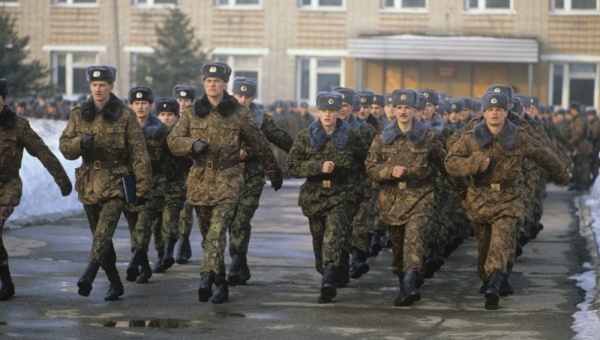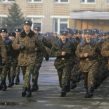
The Russian Military’s Privates Are “Missing”
Publication: Eurasia Daily Monitor Volume: 9 Issue: 17
By:

As the upheaval and confusion in Russia’s Armed Forces persists, stemming from the reform initiated in the fall of 2008, intermittent “comfort” has been sought by resorting to number crunching. The defense ministry leadership and top brass offer the reassuring figure of “one million” men under arms, while few seriously believe the claim to actually reflect the real numbers (Interfax, January 12).
Following the recent holiday season, reports about the numbers of “missing” or vacant private posts in the Armed Forces triggered reflection in the media about the causes and implications of such under manning. This near futile exercise in military numeracy was stimulated by an unnamed source in the Duma defense committee disclosing that “30 percent” of private posts at company level in almost every branch and arm of service are vacant, while in the majority of units in the Ground Forces, Naval infantry and Radiation, Chemical and Biological Protection Troops the figure is 35 percent (Interfax, January 12).
Commenting on this level of under manning in the military, the anonymous source posited the idea that the spring 2012 draft might need to be increased to 300,000, making a clear link between the present shortfalls and the decision to reduce the fall 2011 draft intake. He explained that from the reduced fall 2011 draft of 135,850 conscripts, the military received 100,000 after the other power ministries had creamed off their share. Kommersant explored the theme of the record low draft in the fall of 2011, and how this had impacted on the numbers of personnel in the Armed Forces, noting that 240,000 conscripts were demobilized at the same time as the fresh intake arrived. The article recalled the claims by the General Staff that the “real” size of the Armed Forces is “one million,” which roughly includes 220,000 officers and “200,000” contract personnel with the remainder consisting of conscripts. Leaving aside the problem with defining the precise numbers of contract personnel since this figure varies according to the individual or rank of the speaker offering the figures, the article suggested that under manning in some units may only be around 10 percent, and not quite as much as the higher percentages reported elsewhere. Indeed, Kommersant’s defense ministry source linked this shortage to the “transition” to a new contract personnel system, and was keen to deny the more politically sensitive issue of any possible plans to increase draft numbers in the spring of 2012 (Kommersant, January 16).
It appears that there is no consensus within the Duma defense committee on whether there is any need to adjust the numbers drafted in the spring. Viktor Zavarzin, the Deputy Head of the Duma Defense Committee, ruled out the prospect of the next draft cycle resulting in any shortage of conscripts, while other members of the committee anticipate fresh discussion of the exact numbers required. Kommersant’s interlocutors indicated that the preliminary plans envisage a slightly smaller spring draft than in 2011 (218,700). Valentina Melnikova, the Head of the Union of Soldiers’ Mothers, suggested that the committee should avoid “fantastic draft plans” and instead focus on “legislative support” for the military reform, in order to address the problem of qualified army cadres (Kommersant, Moskovskiy Komsomolets, January 16).
Some observers were puzzled by the plans espoused by the defense ministry to vastly increase contract personnel numbers by 2017 to 425,000, involving recruiting 50,000 kontraktniki annually. The source of their bewilderment is linked to announcing these plans combined with simultaneously reducing the size of the draft intake in the fall of 2011, since the conscript pool is the main source for recruiting kontraktniki. Existing plans, therefore, to gradually switch the balance in the manpower system toward contract service face serious challenges and offer much scope for interpreting the numbers or risk culminating in a de facto extended conscript service simply dubbed as kontraktniki. Commanders will bear the brunt of working out how all this works in the absence of changing the recruitment and promotion system or devising systemic combat training methods that promote the skills demanded by introducing modern high-technology weapons and equipment systems. This theme was touched on briefly by Viktor Litovkin in Nezavisimoye Voyennoye Obozreniye, though he offered a broad range of inter-related aspects of such “fantastic” draft plans (Nezavisimoye Voyennoye Obozreniye, January 18).
Litovkin, following similar media reports, was dismissive of the official “one million” claims, and referred to Nikolai Gogol’s Myortvyye Dushi (Dead Souls) which drew inspiration from nineteenth century Imperial Russian landowners including dead serfs in their official property registers (Nezavisimoye Voyennoye Obozreniye, January 18; EDM, January 18, 2011). Defense Minister Anatoliy Serdyukov habitually declares certain reform aims to be achieved in December of each year, and in December 2010, he duly reported that the target of “reducing” the Armed Forces to “one million,” was successfully implemented. But Litovkin not only observed the serious implications of under manning in terms of combat readiness and ridiculed the idea that such numbers could be realistic, he also utilized his literary model to raise a much more sensitive issue. Clearly, the number crunching regardless of which model of creative accountancy could be used simply fails to reach the target of one million. However, Litovkin highlighted the fact that this is the figure budgeted for in Russian defense planning. Budget funds have been allocated and released to clothe, feed and pay “one million,” consequently it is not so much a question of missing privates but vanishing money (Nezavisimoye Voyennoye Obozreniye, January 18).
Litovkin concludes by saying there is “no answer,” leaving his readership on a precipice as there is an undercurrent too sensitive to state publicly. It is not simply that large portions of the defense budget vanish into black holes in a system that thrives on corruption, but is rooted in the fact that the “dead souls” or other schemes to rip off the state flourish as it has no impact on the elite. Until Russia’s ruling elite allow their sons to enter military service there will be plenty of scope for fantastic numeracy, missing privates and a military culture completely divorced from sound and reliable military statistics.




